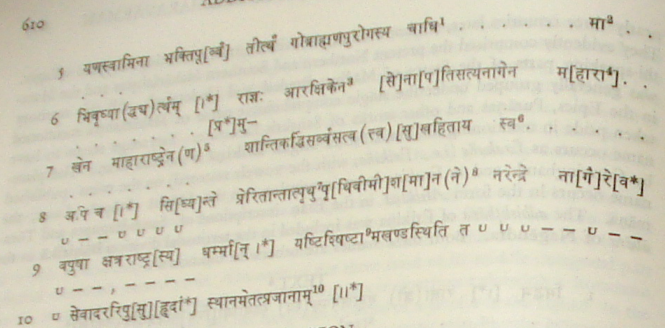|
ADDITIONAL INSCRIPTIONS

______________________
TRANSLATION
Success ! In the victorious twenty-seventh-20 (and) 7-year, augmenting [his
dominion for a thousand years] of the Rājan (and) Mahākshatrapa Śrīdharavarman, the
son of the Śaka Nanda-the righteous conqueror,11 who has obtained abundant fame by
means of victories won by his valour, [who meditates on the feet of the divine Mahāsēna
whose army has never been vanquished12 on this day (namely) . . . . . . . . . .13 in the adhishṭhāna (town) of Ērikiṇa in (the territorial division of) Bāhirikā in
this āhāra of Nagēndra, a tirtha (i.e., a flight of steps) [at the river Vēṇvā][has been caused
__________________
‘a territorial division’, may have followed बाहिरिकायां. The river at which the tīrtha was constructed may
also have been named. The lost portion may, therefore, be conjecturally restored as follows:--पयके देण्वानछां कारितं नरा-.
1 Restore-ष्ठानस्य स्वस्त्यषं. Compare स्वस्त्यस्तु गोव्राह्मणपुरोगाभ्यः in the Ēraṇ inscription of
Budhagupta. C.I.I., Vol. III, p.89.
2 Restore मातापित्रो. पुण्या-.
3 Read राज्ञ वारक्षिकेण.
4 There are fairly clear traces of these two aksharas, but whether the intended word was महाराज- or महाराष्ट्-, it is difficult to say. As Śrīdharavarman bears the title Rājan in lines 1 and 6, it appears
more likely that the word was महाराष्ट्. The missing words may be conjecturally restored as महराष्टा-मिजननावानां प्रमुखेन.
5 The word is formed according to Pāṇini, IV, 3, 90.
6 The lost aksharas may be restored conjecturally as -भोगाघिष्ठानैरिकिणो
Cf. यष्टिरभ्युच्इछ्ता.in the Ēraṇ inscription of Samudragupta, C.I.I., Vol. III, p.20 and स्वभोपनवरंरिकिणप्रदेशे घ्वजस्तम्मोन्पुच्इचृतः in the Ēraṇ stone pillar inscription of Budhagupta, ibid., p.89.
7 Two aksharas, both prosodially short, are wanting here.
8 The correct form would be ईशाने.
9 Read बष्इटश्इक्षष्टा-. As the root शासू is Parasmaipadī, the correct grammatical form would be
चास्तु
10 Metre: Sragdharā.
11 Kauṭilya speaks of three types of kings: (i) dharmavijayiṅ or a righteous conqueror, (ii) asuravijayin or a devilish conqueror and (iii) lōbhavijayiṅ or an avaricious conqueror. Arthaśāstra, adhikaraṇa xii, 1.
Kālidāsa describes Raghu as dharmavijayiṅ, Raghuvamśa canto iv, v. 43. Here as well as in the Kānā-
khērā inscription Śrīdharavarman claims to b e a righteous conqueror.
12 The portion in the rectangular bracketes in this and other places is the translation of the ex-
pressions restored conjecturally in the foot-notes to the text. See above, p. 609, n. 6; cf. l. 1 of No 5,
above.
13 The portion lost at the end of line 3 probably mentioned the month, fortnight and tithi of
the event as in 1. 3 of No. 5, above.
CORPUS INSCRIPTIONUM INDICARUM
VOL. IV. PLATE XCVIII.
ERAN STONE PILLAR INSCRIPTION OF SRIDHARAVARMAN

Home
Page |